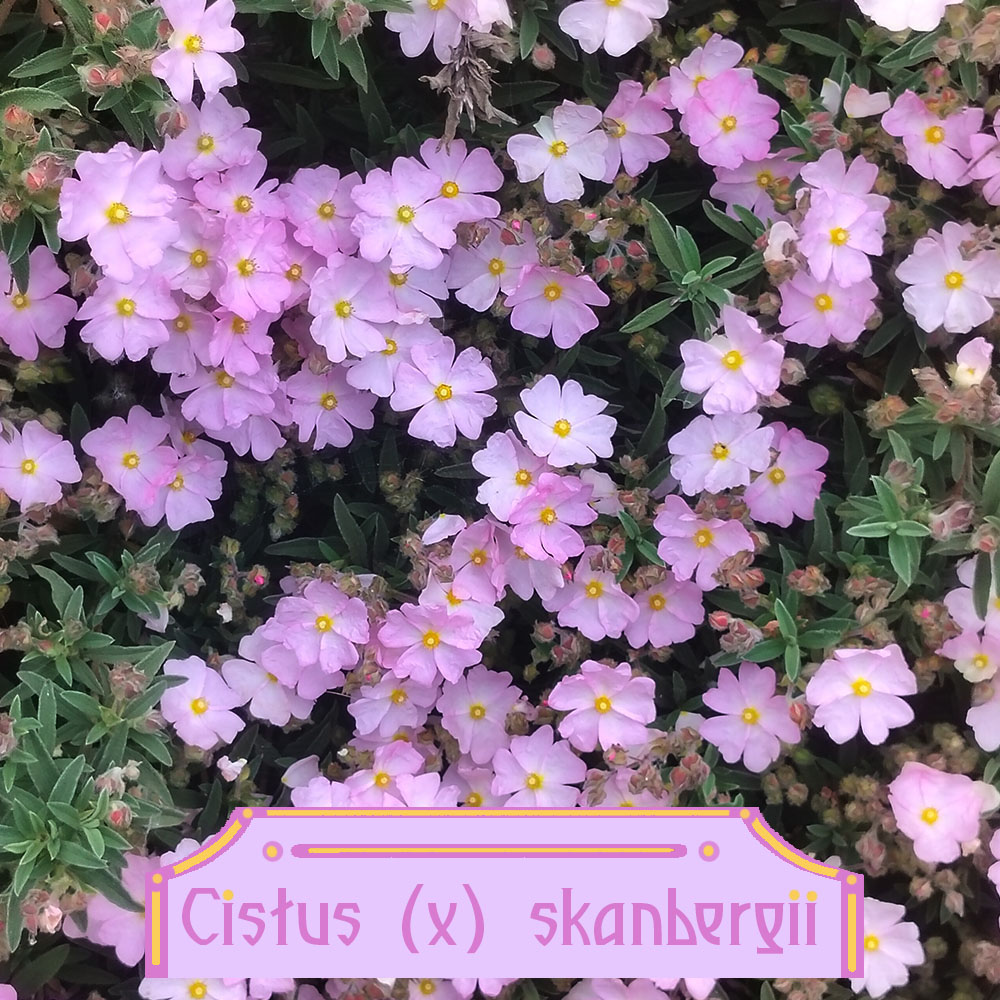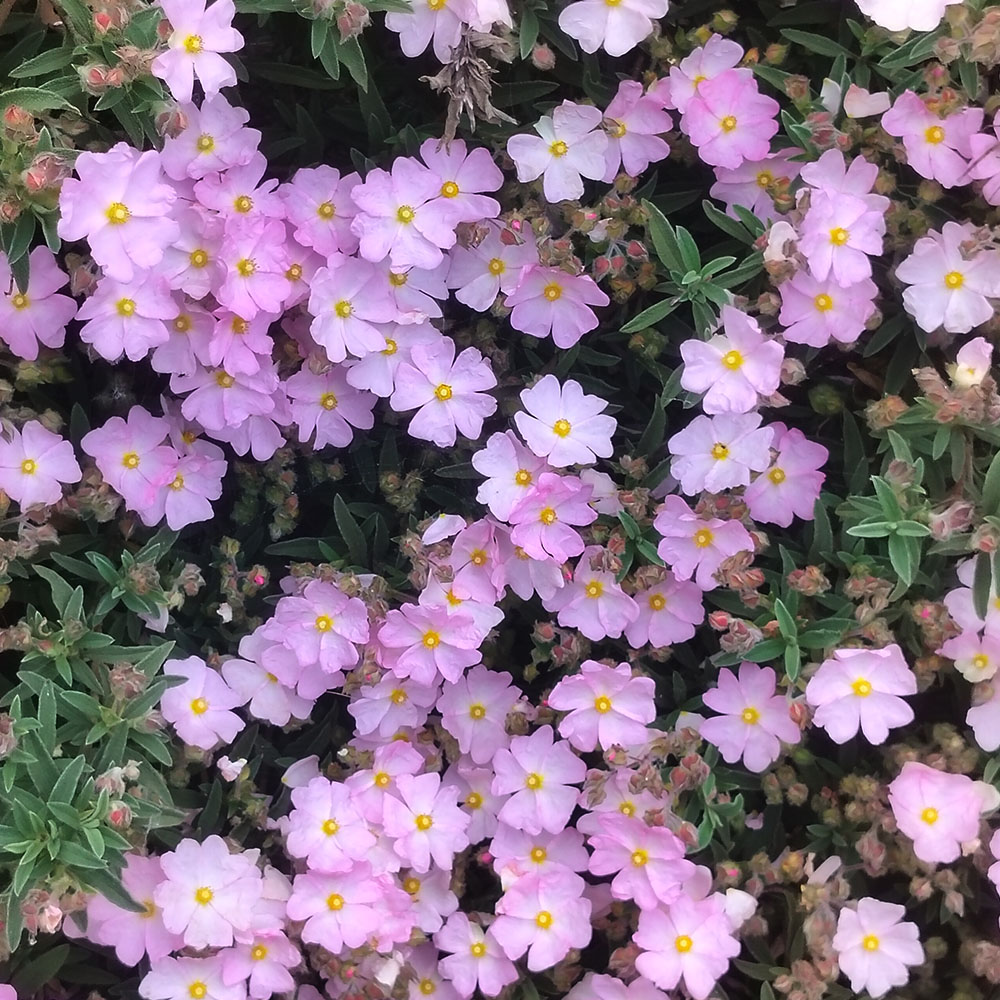-
 4,90 € × 1×€4.9
4,90 € × 1×€4.9
Customer matched zone "Locations not covered by your other zones"
“Cistus x skanbergii – Ciste nain” has been added to your cart. View cart
Cistus x skanbergii – Ciste nain
A silver-grey bush that is covered in pink flowers in summer.
Rated 0 out of 5
0 customer reviews
4,90 €
Tags: aromatique, bouquets, couleur, evergreen, feuillage persistant, graphique, Jardin Méditerranéen, longue floraison, Mediterranean, pepiniere lhoumois, secheresse, soleil, vivace, vivace en pot, xeriscaping
SKU: pda435
Category: Bees and Butterflies, Evergreen, Fragrant, Frost Hardy, Ground Cover, Rewild

Cistus x skanbergii - Ciste nain
4,90 €
Cistus skanbergii (Cistus x skanbergii) forms an almond-green ball covered with fine, very gray foliage that is covered entirely in the early summer by a blanket of pale pink flowers.
The leaves are evergreen, small, narrow, and elongated. This variety is particular as the leaves are covered with a velvety layer of grey.
The flowers are slightly silvery pink with salmon hues, revealing at their center a cluster of golden stamens.
The root system is both deep and branched. It is so powerful that it can penetrate fractured rocks to extract even the slightest trace of moisture deep underground – making it one of the most drought tolerant plants of the Mediterranean region.
Highly fragrant, the blooms attract butterflies.
Though each flower lasts only a day, their abundance and continuous renewal create a spectacular floral display for several weeks.
👨🌾GARDENING TIPS👨🌾:
-
- ✂️ Cistus can be lightly pruned after flowering and pinched back to promote a bushy growth, but avoid cutting into old wood.
- 🪰 Their thick leaves + resin do not attract pests, though their delicate flowers can be damaged by heavy rain
- 🏠 Avoid transplanting them once they are settled, as their roots do not like to be disturbed.
🌱🌿pdA Garden Buddy Suggestions🌱🌿 :
Learn more about Gardening with the Cistus family:
The Tales & The Botany:
It is a natural hybrid between Cistus monspeliensis and Cistus parviflorus, two species commonly found in Cyprus. In its natural habitat, the vigor of Cistus x skanbergii allows it to outcompete both parent species and even to take over the terrain.
Cistus x skanbergii tolerates limestone well so it can be planted in areas where other plants may falter.
The genus Cistus was named by French botanist Joseph Pitton de Tournefort, derived from the Greek Kistos, which was later Latinized as Cisthos by Pliny the Elder. The genus includes around twenty Mediterranean shrub species in the Cistaceae family, closely related to Halimium and Helianthemum.
These plants have opposite, evergreen to semi-evergreen leaves that are oval to lanceolate, sometimes elongated. Some species, like Cistus ladanifer, contain aromatic resin used to produce medicinal labdanum.
Labdanum is a sticky brown resin extracted from the Cistus plants that is still used to produce perfume and vermouth. You’ll see when you touch the plant, it’s quite sticky.
🔥 Their fruits are fire-resistant capsules, allowing them to reseed naturally after a wildfire.
🥷 They also suppress weed growth through allelopathy (releasing substances that inhibit weed germination) something that our friends in the Thyme family are infamous for.
🌸 Floral Morphology
Members of the Cistaceae, including the genus Cistus, typically produce solitary or cymose inflorescences with showy, crêpe-like petals.
Flowers are actinomorphic (characterized by radial symmetry), pentamerous, and range from 2 to 8 cm in diameter depending on species. Petals are usually white, pink, or purple with conspicuous yellow stamens. Sepals (3–5) are persistent and may be hairy or glabrous.
Leaves are opposite, simple, entire, and often covered with glandular trichomes secreting aromatic resins such as labdanum. This resin imparts drought resistance and fragrance.
🌱 Reproductive Biology
Flowers are hermaphroditic, often protandrous (anthers mature before stigmas), which encourages cross-pollination. Despite this, many species retain a level of self-compatibility, ensuring reproduction under low-pollinator conditions.
Pollination is predominantly entomophilous, with bees, beetles, and flies visiting for pollen rather than nectar.
Seeds are borne in dehiscent capsules containing numerous small seeds adapted for germination after disturbance (particularly fire).
🌍 Ecology & Adaptations
Cistaceae are emblematic of Mediterranean-type ecosystems on poor, rocky soils. Key adaptations include:
-
-
High Drought tolerance via resinous, sclerophyllous (a sclerophyll is a type of vegetation that is adapted to long periods of dryness and heat) leaves.
-
Fire-related regeneration, with seeds requiring heat shock or smoke compounds to germinate.
-
Symbiosis with mycorrhizal fungi (notably Tuber spp.), which enhance nutrient uptake in low-fertility soils.
-
Other Names:
Rockrose
Origin:
Mediterranean
| Weight | 0,5 kg |
|---|---|
| Flower Color | 🩷 Pink |
| Flowering | April, May, June |
| Exposure | Full Sun |
| Frost Tolerance | -10°C to -15°C |
| Size | 0,6m H x 0,9m W |
| Soil | Dry, Poor, Sandy, Well-Draining |
| Planting Season | March to May, September to November |
Reviews
0
Rated 0 out of 5
0 customer reviews
5
0
4
0
3
0
2
0
1
0
Only logged in customers who have purchased this product may leave a review.
You may also like…
Cistus nigricans
A bush with dark green fragrant leaves that smell of summer
A bush with dark green fragrant leaves that smell of summer
Rated 0 out of 5
Helichrysum italicum
An evergrey, fragrant perennial that will bring a distinctly Mediterranean atmosphere.
An evergrey, fragrant perennial that will bring a distinctly Mediterranean atmosphere.
Rated 0 out of 5
Lavandula stoechas
A highly aromatic, velvet-leaved, drought resistant, flowering perennial.
A highly aromatic, velvet-leaved, drought resistant, flowering perennial.
Rated 0 out of 5
Santolina chamaecyparissus
A fragrant, evergreyshrub with little yellow button flowers in summer
A fragrant, evergreyshrub with little yellow button flowers in summer
Rated 0 out of 5
Thymus ‘Duftkissen’
An intensely fragrant and profusely flowering thyme with grey-green, soft leaves.
An intensely fragrant and profusely flowering thyme with grey-green, soft leaves.
Rated 0 out of 5
Related Products
Erigeron kavinskianus
A daisy-like carpet of flowers
A daisy-like carpet of flowers
Rated 0 out of 5
Tradescantia Blushing Bride
Gorgeous blushes of pink and white that appear in the coldest nights.
Gorgeous blushes of pink and white that appear in the coldest nights.
Rated 0 out of 5
Glechoma hederacea
A sweet smelling ground cover, producing little blue flowers all summer long.
A sweet smelling ground cover, producing little blue flowers all summer long.
Rated 0 out of 5
Melissa officinalis
A perennial plant in the mint family that is adored by bees, royal families and tea drinkers.
A perennial plant in the mint family that is adored by bees, royal families and tea drinkers.
Rated 0 out of 5
Euphorbia myrsinites
Known for its draping form of silver-gray foliage and radiant blooms.
Known for its draping form of silver-gray foliage and radiant blooms.
Rated 0 out of 5
Artemisia Valerie Finnis
A semi-evergreen, aromatic variation on the theme of Artemisia.
A semi-evergreen, aromatic variation on the theme of Artemisia.
Rated 0 out of 5
Stachys byzantina
Silky white-grey leaves and tall striking flowers
Silky white-grey leaves and tall striking flowers
Rated 0 out of 5
Echinacea purpurea
A perennial with purple flowers all summer long
A perennial with purple flowers all summer long
Rated 0 out of 5
Delosperma cooperi
A dwarf perennial known for its vermillion colored flowers
A dwarf perennial known for its vermillion colored flowers
Rated 0 out of 5
Hellebore argutifolius
Winter flowering perennial with marbled blue-green leaves
Winter flowering perennial with marbled blue-green leaves
Rated 0 out of 5
Vinca minor
Looping elegance and ability to form a low flowering ground cover
Looping elegance and ability to form a low flowering ground cover
Rated 0 out of 5
Trachelospermum asiaticum ‘Ogon Nishiki’
Jasmine with colorful foliage and lovely white flowers in summer
Jasmine with colorful foliage and lovely white flowers in summer
Rated 0 out of 5
Sedum album
A low, multi-color ground cover.
A low, multi-color ground cover.
Rated 0 out of 5
Euphorbia cyparissias Clarice Howard
A Euphorbia that resembles a soft little cyprus tree
A Euphorbia that resembles a soft little cyprus tree
Rated 0 out of 5
Kalanchoe daigremontiana
A toothy succulent from Madagascar, known as the Mother of Thousands.
A toothy succulent from Madagascar, known as the Mother of Thousands.
Rated 0 out of 5
Hieracium maculatum Leopard
A native perennial with blue-green leaves and a tall yellow flower
A native perennial with blue-green leaves and a tall yellow flower
Rated 0 out of 5
Mentha x piperita ‘Chartreuse’
A spicy mint, known for its use in the production of liqueurs and herbal teas.
A spicy mint, known for its use in the production of liqueurs and herbal teas.
Rated 0 out of 5
Tanacetum densum subsp amani
A shrublet composed of soft, finely divided silvery gray-white leaves.
A shrublet composed of soft, finely divided silvery gray-white leaves.
Rated 0 out of 5
recent view product
Gypsophila cerastiodes
A cushion of mouse ears and delicate white flowers
A cushion of mouse ears and delicate white flowers
Rated 0 out of 5
Chrysanthemum Dernier Soleil
A perennial with large yellow flowers tipped with coppery-orange hues
A perennial with large yellow flowers tipped with coppery-orange hues
Rated 0 out of 5
Delphinium requienii
Lilac-metallic flowers on tall spires
Lilac-metallic flowers on tall spires
Rated 0 out of 5
Centranthus ruber Albus
A wonderfully resilient perennial, producing white panicles all summer long.
A wonderfully resilient perennial, producing white panicles all summer long.
Rated 0 out of 5

























































There are no reviews yet.